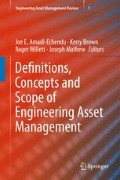Abstract
Various industrial sectors are interested in adopting Total Quality Management (TQM) today as they meet new challenges. At the same time, protection of the environment is also an issue constantly demanded from assets. In this emerging context, managing environmental sustainability through operational excellence in seaports is an important issue to be addressed. The managerial excellence here depends on many factors, for instance, personnel, organization, processes, etc.
Notably, Egyptian seaports have not often been seen applying or using any formal comprehensive environmental or quality management system to date. Therefore, a project was initiated in one of the major commercial seaports in Egypt, with the intention of developing a suitable methodology to enhance environmental sustainability through a comprehensive quality management process. In this novel method, the well-known European Foundation for Quality Management (EFQM, which represents TQM), and what is called Port Environmental Review System (PERS) – an Environmental Management System (EMS) – were integrated together to develop an integrated methodology for managing environmental sustainability. This covered a number of aspects which are important to resolve current challenges and problems in Egyptian seaports in environmental management terms.
This paper discusses the integration of EFQM and PERS as the basis for the development of a comprehensive method, termed an Integrated Method for Environmental Sustainability Management (IMESM), for a commercial seaport. It demonstrates an attempt to make a strategic combination of quality and environmental review processes to develop a management framework. This method was developed in close cooperation with a seaport in Egypt to ensure that it is sensible as well as practically relevant to the industrial sector.
Access this chapter
Tax calculation will be finalised at checkout
Purchases are for personal use only
References
Kluwen, J., & Tabak, W. (1997) Pilotage and Total Quality Concept, Seaways bulletin, August, pp. 12–15.
EMDB (2004) Egyptian Maritime Data Bank Ministry of Transport, Maritime Transport Sector.
Balbaa, A., Liyanage J.P. (2007) ‘Investigation of the current status of pollution and its root causes in A-port’, west Damitta city, Egypt. Egyptian Journal of Aquatic Research, vol. No. 2, pp. 13–30, (2007), ISSN 1687-4285.
Labib, A. (2004) An investigation into the casual indicators and associated critical parameters for effective quality management in first generation Egyptian ports exemplified by the port of Alexandria, PhD dissertation, West England, UK, University of West of England.
ESPO (2004) Seaport policy – A practical guide for EU policy makers, Brussels, 24 November 2004, http:// www.espo.be.
Balbaa, A., Liyanage, J.P. (2007) ‘Environmental Management Systems vs. Total Quality: Improving environmental sustainability of seaports in Egypt.’ 6th International Conference Quality, Reliability and Management (QRM 2007). 22nd–23rd March 2007, Oxford, UK, pp. 7–12.
Naniopoulos, A., et al. (2006) Sustainable development of port operations: the role of research led education Shipping in the era of social responsibility, Argostoli, Cophalonia, Greece, 14–26 September 2006.
ESPO (2003) Environmental Code of Practice. ESPO, Brussels.
Darbra, R., et al. (2004) The self Diagnosis Method A new methodology to assess environmental management in seaports, Marine Pollution Bulletin Vol. No. 48 (2004), Science Direct. pp. 420–428.
PIANC (1999) Environmental Management Framework for Ports and Related Industries, International Navigation Association, Report of Working Group 4.
Eco-information, (1999) Eco-information in European Ports, Final Report, ESPO, Brussels.
Casal, I., et al. (1999) Assessment of the environmental situation in seaports 1st International Congress on Maritime Technological Innovations and Research, 21–23 April 1999, pp. 341–350.
Eco-Ports (2008) www.ecoports.org.
Moller, J., et al. (2000) Quality Management in the German Health Care – the EFQM Excellence Model, International Journal of Health Care Quality Assurance, 13/6, pp. 254–258.
Nabtize, U.W. & Klazinage, N.S. (1999) EFQM approaches and Dutch quality Award, International Journal of Health Care, Quality Assurance Journal, 12/26 pp. 5–70.
Gavare, R., Isaksson, R. (2001) Sustainable development: Extending the scope of business excellence models Measuring Business Excellence 5, 3 2001, MCB University Press, 1368–3047, pp. 11–15.
Edgeman, R. (2000) Lectures in sustainable development, September, Lulea Sweden.
Paixao, A.C. & Marlow, B.P. (2003) Fourth generation ports – a Question of agility? International Journal of Physical Distribution & Management, 33 (4), pp. 355–376.
Puffer, S.M., & McCathanthy, D.J. (1996) A Framework for leadership in TQM context. Journal of Quality Management, 1, 109–130.
Author information
Authors and Affiliations
Editor information
Editors and Affiliations
Rights and permissions
Copyright information
© 2010 Springer
About this chapter
Cite this chapter
Balbaa, A., Liyanage, J. (2010). On the Development of an Integrated Framework Based on ‘PERS’ and ‘EFQM’ for Environmental Sustainability Management in Seaports: A Case from Egypt. In: Amadi-Echendu, J., Brown, K., Willett, R., Mathew, J. (eds) Definitions, Concepts and Scope of Engineering Asset Management. Engineering Asset Management Review, vol 1. Springer, London. https://doi.org/10.1007/978-1-84996-178-3_15
Download citation
DOI: https://doi.org/10.1007/978-1-84996-178-3_15
Publisher Name: Springer, London
Print ISBN: 978-1-84996-177-6
Online ISBN: 978-1-84996-178-3
eBook Packages: EngineeringEngineering (R0)

